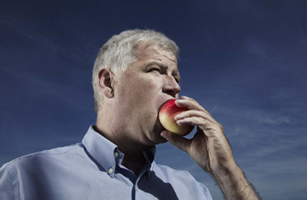
Those of us who have never used a wooden fruit crate for anything besides storing our record collections could take a lesson in repurposing from Thomas Harttung. From his farm in Barritskov, Denmark, the 48-year-old has built a sustainable empire around the humble box, using them to ship the chemical-free fruits and vegetables he sells, and then converting those same boxes into fuel to heat his farm operation. And fertilize its soil. And sequester its carbon.
When Harttung started his company in 1999, he provided his 100 customers with regular deliveries of produce grown on his own small vegetable farm. Ten years later, Aarstiderne is the world's largest box scheme, sending crates of produce to the doorsteps of 40,000 Danish subscribers, 6,000 Swedes and a handful of Germans each week. In the warm seasons about 30% of the lettuce and carrots and garlic and berries that fill those boxes comes from the farm that Harttung inherited from his parents. The rest come from other Danish growers, or — in the case of the oranges, bananas and year-round tomatoes — small organic producers in Spain, Italy and France. To reduce carbon emissions, the company imposes a no-fly rule: all produce must travel by truck or boat.
For hard-core locavores, Aarstiderne's willingness to ship food across great distances and — horrors! — offer tomatoes in April, is high treason. But Harttung takes a pragmatic approach to changing the world's eating habits: he aims for organic first and trusts the rest will follow. "Look, people want their oranges," he says. "We could be very high church about this, but then we would lose part of the congregation we're trying to convert. So we give them organic oranges and we hope that, if we're flexible, it will help them develop a more sustainable mind-set."
Harttung is now focusing on an even bigger concern: climate change. Under his "Green Carbon" initiative, he is developing ways of offsetting 100% of his farm's emissions and increasing its carbon-sequestration capacity. Outside Aarstiderne's administrative office, there's a weird-looking contraption in a greenhouse. The machine burns organic material in an oxygen-depleted environment to produce a charcoal-like substance called biochar, which works as a potent fertilizer and has the capacity to sequester carbon dioxide. By attaching an engine to the machine, Harttung produces enough clean, renewable energy to supply 60% of Aarstiderne's power needs. The magic material that Harttung burns in his plant: worn crates.